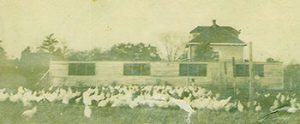 Early in the 20th century, a second-generation immigrant, Edward Joseph Frankenhoff, left his home in Mt. Adams and his job at the downtown Cincinnati Kroger’s and moved his young family to Indian Hill to farm. He purchased 10 acres that overlooked Madisonville. It was a plot of ground set back from the road on western Indian Hill Rd. There he started raising chickens to support his family. With a horse drawn wagon, he delivered eggs and dressed chickens to local customers; and in summer sold his surplus garden produce.
Early in the 20th century, a second-generation immigrant, Edward Joseph Frankenhoff, left his home in Mt. Adams and his job at the downtown Cincinnati Kroger’s and moved his young family to Indian Hill to farm. He purchased 10 acres that overlooked Madisonville. It was a plot of ground set back from the road on western Indian Hill Rd. There he started raising chickens to support his family. With a horse drawn wagon, he delivered eggs and dressed chickens to local customers; and in summer sold his surplus garden produce.
Frankenhoff’s chickens were white leghorns, which were prolific; but their eggs were small. Once the hens no longer produced, they were sold for their meat. Dixie, the family “mutt”, kept watch over the poultry, keeping the fox from the hen house. Dixie barked at chicken hawks and even at airplanes overhead. If a chicken flew into the wrong pen, she gently retrieved it for her master.
 This farming operation provided a living for the family. Mrs. (Amelia) Frankenhoff and their children Angela and Edwin chipped in when necessary. As business grew, Frankenhoff acquired a Model T delivery truck and dreamed of a grocery storefront close to the road. The driveway from Indian Hill Rd. to the chicken farm was a rocky nuisance, and the family joked that “the rocks must reach clear to China.”
This farming operation provided a living for the family. Mrs. (Amelia) Frankenhoff and their children Angela and Edwin chipped in when necessary. As business grew, Frankenhoff acquired a Model T delivery truck and dreamed of a grocery storefront close to the road. The driveway from Indian Hill Rd. to the chicken farm was a rocky nuisance, and the family joked that “the rocks must reach clear to China.”
In the 1920’s Indian Hill real estate was attracting wealthy Cincinnatians; and W. S. Rowe, President of the First National Bank, approached Frankenhoff about selling the chicken farm. Frankenhoff set a price at the then high price of $5,000, to which Rowe agreed; and the farm sold. The buildings were razed, and Rowe built his home (Goodwood) on the land.
With the proceeds of the sale, Frankenhoff purchased 1.8 acres at nearby 7335 Indian Hill Rd. The house had 3 rooms upstairs and 3 rooms downstairs – one of which became the “store room,” later known as Frankenhoff’s Grocery Store. The merchandise line expanded, and Frankenhoff got a bigger truck and extended his delivery route. He took groceries to Indian Hill customers two days a week and to Madisonville and Plainville, each once a week. Fridays, he went to town to buy from the wholesalers (Jansen Company and Helmer’s). Saturdays were spent stocking the shelves and the truck, with surplus inventory stored in the hand-built garage, ready to replenish sold merchandise.
The grocery business flourished, and Frankenhoff’s was well known in the area. While Edward was making deliveries, the store was open for customers who preferred to walk, ride, or drive there. Amelia and Angela tended the store. Many kinds of canned goods, staples, and soap powders (e.g. Fels Naptha, Super Suds, and Chipso) were available. Not many lunchmeats were sold because the store had an icebox, not an electric refrigerator. In those days the delivery truck did most of the business. During the 1920’s and 1930’s, home delivery of ice blocks, baked goods, and dairy products was also common.
The Depression hurt the business since people “made do” with less. Frankenhoff extended credit to some families who were unable to pay. Then Kroger’s and Albers (larger competing grocery store chains) had a price war, and sold merchandise for less than Edward paid wholesalers. As a consequence, the family closed the grocery, sold their property, and relocated to Pt. Pleasant, Ohio (Clermont County) in 1936. The original building (constructed c.1870) has since been converted to a private residence.
When Frankenhoff’s Grocery Store closed its doors, it was the end of an era. As a commercial establishment, it had served Indian Hill residents and people of adjacent communities. The independent grocery became a part of village history.
